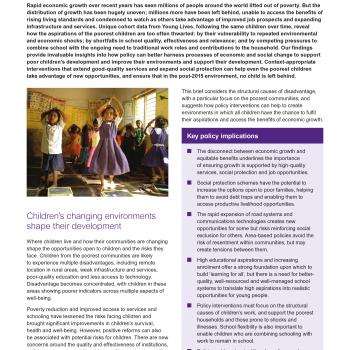Publication Information

Rapid economic growth over recent years has seen millions of people around the world lifted out of poverty. But the distribution of growth has been hugely uneven; millions more have been left behind, unable to access the benefits of rising living standards and condemned to watch as others take advantage of improved job prospects and expanding infrastructure and services. Unique cohort data from Young Lives, following the same children over time, reveal how the aspirations of the poorest children to grasp new opportunities are too often thwarted: by their vulnerability to repeated environmental and economic shocks; by shortfalls in school quality, effectiveness and relevance; and by competing pressures to combine school with the ongoing need to traditional work roles and contributions to the household. Our findings provide invaluable insights into how policy can better harness processes of economic and social change to support poor children’s development and improve their environments and support their development. Context-appropriate interventions that extend good-quality services and expand social protection can help even the poorest children take advantage of new opportunities, and ensure that in the post-2015 environment, no child is left behind.

Rapid economic growth over recent years has seen millions of people around the world lifted out of poverty. But the distribution of growth has been hugely uneven; millions more have been left behind, unable to access the benefits of rising living standards and condemned to watch as others take advantage of improved job prospects and expanding infrastructure and services. Unique cohort data from Young Lives, following the same children over time, reveal how the aspirations of the poorest children to grasp new opportunities are too often thwarted: by their vulnerability to repeated environmental and economic shocks; by shortfalls in school quality, effectiveness and relevance; and by competing pressures to combine school with the ongoing need to traditional work roles and contributions to the household. Our findings provide invaluable insights into how policy can better harness processes of economic and social change to support poor children’s development and improve their environments and support their development. Context-appropriate interventions that extend good-quality services and expand social protection can help even the poorest children take advantage of new opportunities, and ensure that in the post-2015 environment, no child is left behind.

